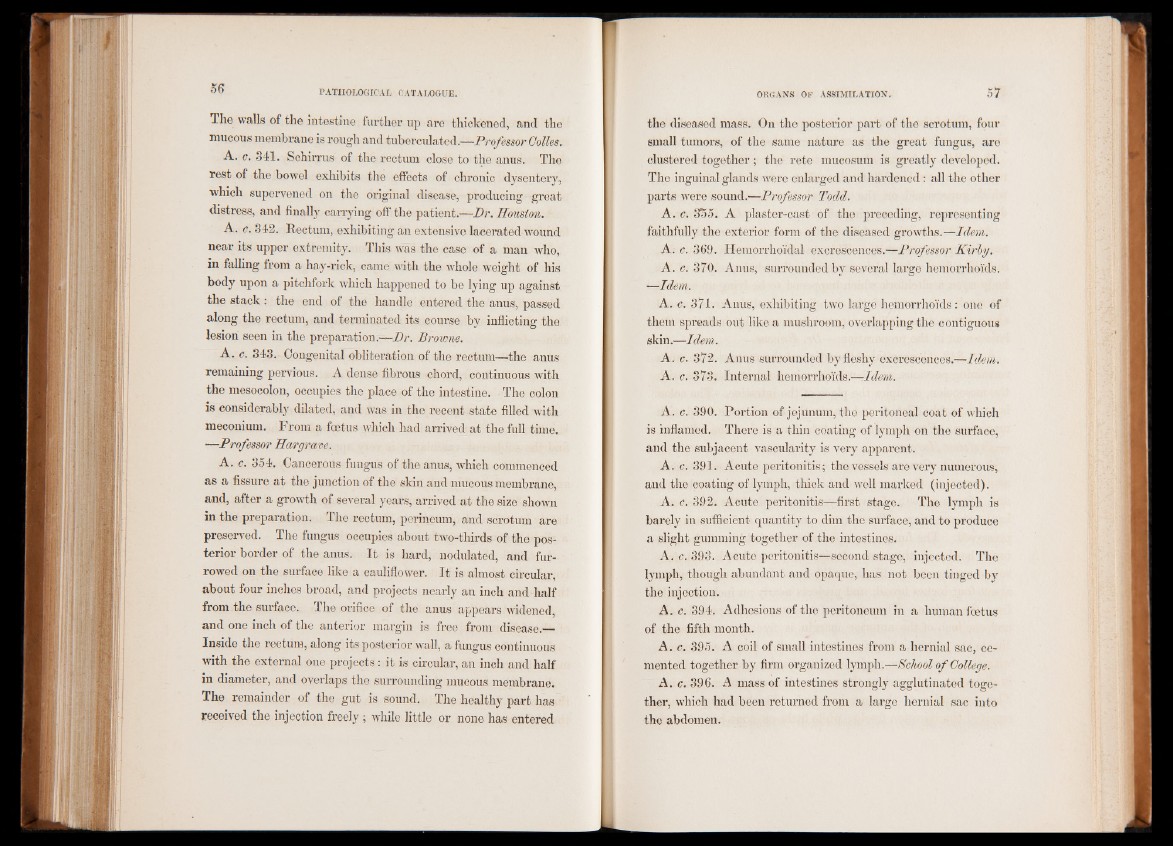
The walls of the intestine further up are thickened, and the
mucous membrane is rough and tuberculated.—Professor Cottes.
A. c. 341. Schirrus of the rectum close to the anus. The
rest of the bowel exhibits the effects of chronic dysentery,
which supervened on the original disease, producing great
distress, and finally carrying off the patient.—Dr. Houston.
A. c. 342. Rectum, exhibiting an extensive lacerated wound
near its upper extremity. This was the case of a man who,
in falling from a hay-rick, came with the whole weight of his
body upon a pitchfork which happened to be lying up against
the stack : the end of the handle entered the anus, passed
along the rectum, and terminated its course by inflicting the
lesion seen in the preparation.—Dr. Browne.
A. c. 343. Congenital obliteration of the rectum—the anus
remaining pervious. A dense fibrous -chord, continuous with
the mesocolon, occupies the place of the intestine. The colon
is considerably dilated, and was in the recent state filled with
meconium. From a foetus which had arrived at the full time.
—Professor Hargrave.
A. c. 354. Cancerous fungus of the anus, which commenced
as a fissure at the junction of the skin and mucous membrane,
and, after a growth of several years, arrived at the size shown
in the preparation. The rectum, perineum, and scrotum are
preserved. The fungus occupies about two-thirds of the posterior
border of the anus. It is hard, nodulated, and furrowed
on the surface like a cauliflower. It is almost circular,
about four inches broad, and projects nearly an inch and half
from the surface. The orifice of the anus appears widened,
and one inch of the anterior margin is free from disease._
Inside the rectum, along its posterior wall, a fungus continuous
with the external one projects : it is circular, an inch and half
in diameter, and overlaps the surrounding mucous membrane.
The remainder of the gut is sound. The healthy part has
received the injection freely ; while little or none has entered
the diseased mass. On the posterior part of the scrotum, four
small tumors, of the same nature as the great fungus, are
clustered together; the rete mucosum is greatly developed.
The inguinal glands were enlarged and hardened: all the other
parts were sound.—Professor Todd.
A. c. 3o5. A plaster-cast of the preceding, representing
faithfully the exterior form of the diseased growths.—Idem.
A; c. 369. Hemorrhoidal excrescences.—Professor Kirby.
A. c. 370. Anus, surrounded by several large hemorrhoids.
—Idem.
A. c. 371. Anus, exhibiting two large hemorrhoids: one of
them spreads out like a mushroom, overlapping the contiguous
skin.—Idem.
A. c. 372. Anus surrounded by fleshy excrescences.—Idem.
A. c. 373. Internal hemorrhoids.—-Idem.
A. c. 390. Portion of jejunum, the peritoneal coat of which
is inflamed. There is a thin coating of lymph on the surface,
and the subjacent vascularity is very apparent.
A. c. 391. Acute peritonitis; the vessels are very numerous,
and the coating of lymph, thick and well marked (injected).
A. c. 392. Acute peritonitis—first stage. The lymph is
barely in sufficient quantity to dim the surface, and to produce
a slight gumming together of the intestines.
A. c. 393. Acute peritonitis—second stage, injected. The
lymph, though abundant and opaque, has not been tinged by
the injection.
A. c. 394. Adhesions of the peritoneum in a human foetus
of the fifth month.
A. c. 395. A coil of small intestines from a hernial sac, cemented
together by firm organized lymph.—School of College.
A. c. 396. A mass of intestines strongly agglutinated together,
which had been returned from a large hernial sac into
the abdomen.